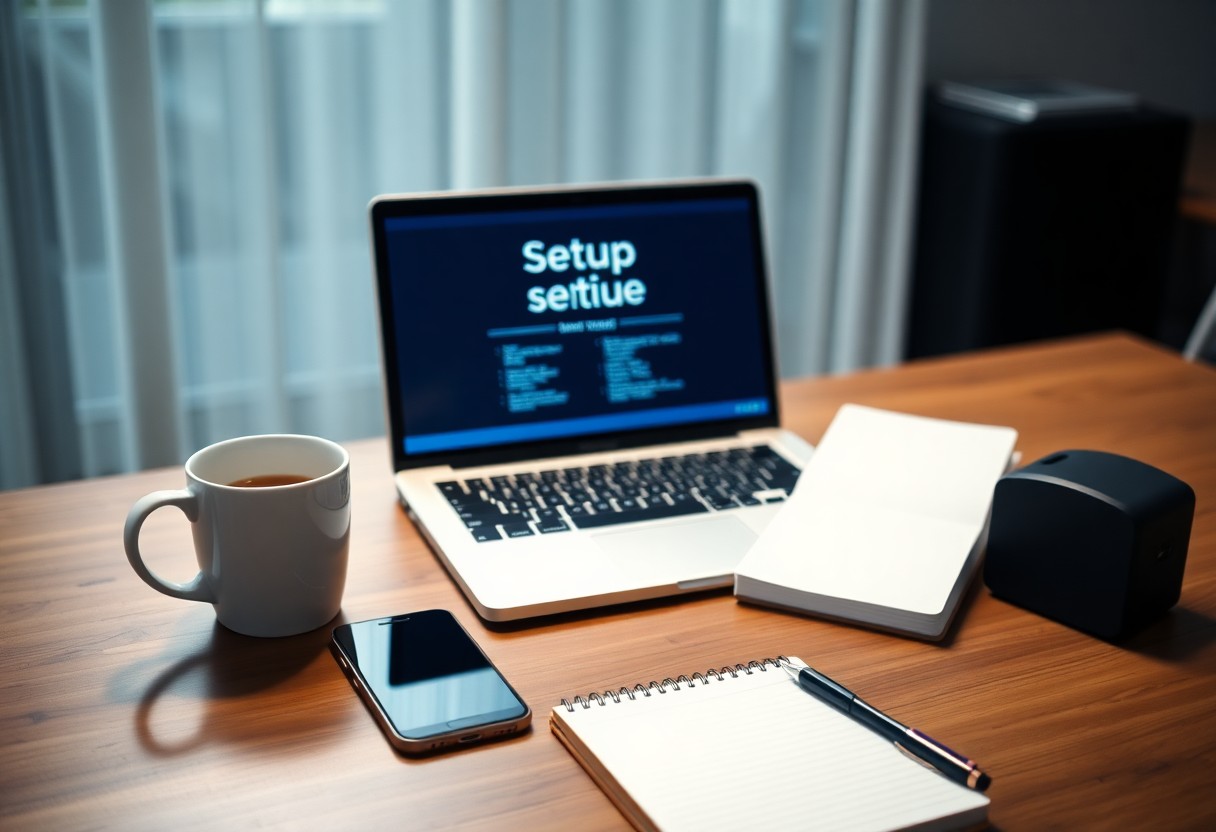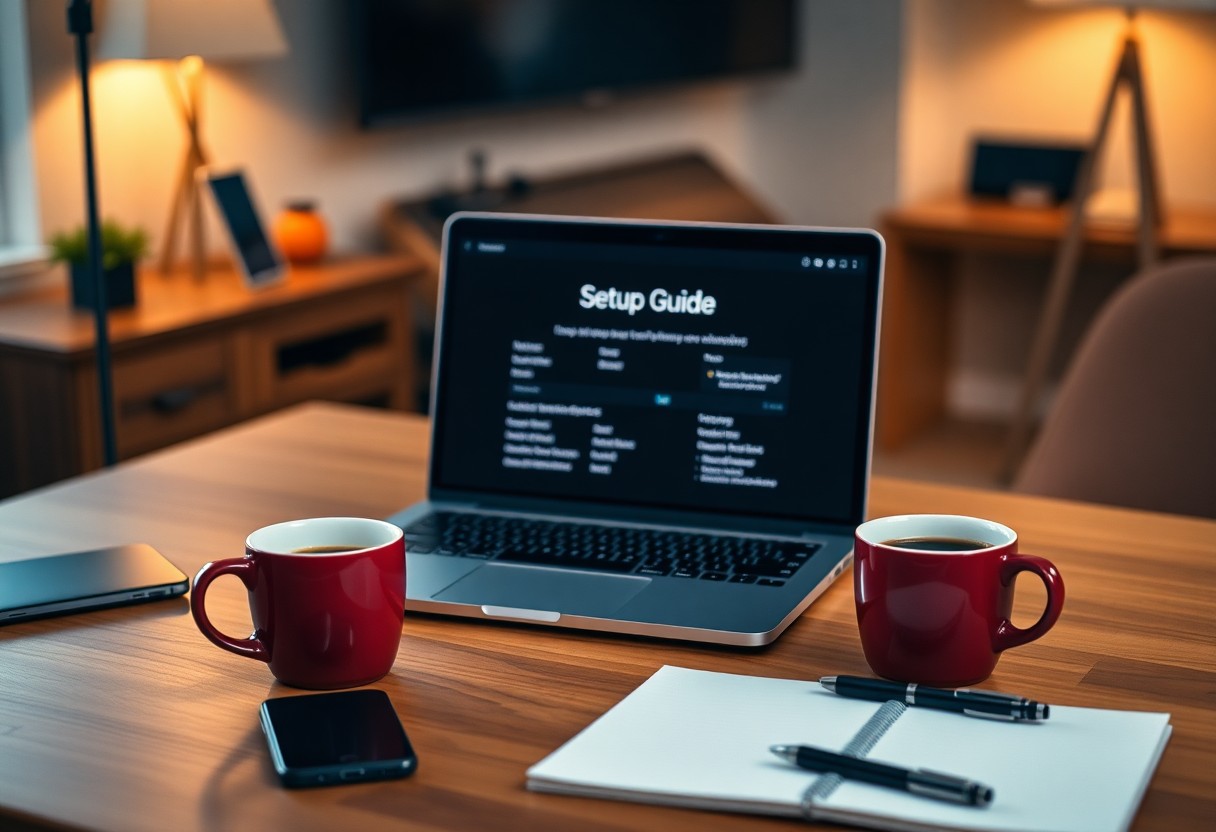Most people find the initial setup of a new laptop daunting, but with this comprehensive guide, you’ll find it simple and straightforward. From unboxing to configuring your settings, we’ll walk you through each step to ensure that your device is ready to use efficiently. You’ll learn how to connect to Wi-Fi, install imperative software, transfer files, and personalize your settings, all aimed at providing you with the best experience possible. Let’s get started on making your new laptop feel like home!
Contents
- Gathering the Essentials
- Choosing the Right Laptop
- Understanding Laptop Specifications
- Initial Setup
- Unboxing Your New Laptop
- Connecting to Power and Peripherals
- Software Installation
- Operating System Setup
- Essential Applications and Tools
- Customizing Your Laptop
- Personalizing Settings
- Enhancing Security Features
- Maintenance Tips
- Keeping Your Laptop Clean
- Regular Software Updates
- Troubleshooting Common Issues
- Identifying Hardware Problems
- Resolving Software Glitches
- Summing up
Gathering the Essentials
The initial step in setting up your new laptop is gathering all the importants. Before venturing into the setup process, ensure you have the necessary components: the laptop itself, power adapter, any external devices like a mouse or keyboard, and your internet connection. Additionally, consider software that may need installation, such as antivirus programs or productivity suites. Having these items ready will streamline your setup experience and get you started on the right foot.
Choosing the Right Laptop
On your journey to setting up a new laptop, selecting the right model is integral. Consider your primary usage patterns—whether it’s for casual browsing, gaming, or professional work—then choose a laptop that aligns with those needs. Look for a model that balances performance, battery life, and portability, while also fitting your budget.
Understanding Laptop Specifications
Assuming you’re eager to make the most of your new device, you should familiarize yourself with key laptop specifications. These include the processor type, RAM size, storage capacity, display quality, and graphics capabilities. Each element plays a vital role in the overall performance and usability of your laptop.
Right from processing power to display resolution, understanding these specifications can significantly enhance your computing experience. For instance, a high-performance processor is important for multitasking, while ample RAM ensures smooth operation, especially when running multiple applications. Storage options, such as SSDs, provide fast data access, while a larger hard drive may offer more space for files. Lastly, consider the display specifications, as a high-resolution screen can provide a better visual experience whether you’re working or enjoying media.
Initial Setup
Now that you’ve acquired your new laptop, it’s time for the initial setup process. This phase is necessary for getting your device up and running smoothly. Start by unboxing your laptop with care, making sure you locate all included accessories before powering it on. Once you have everything ready, you’ll be prepared to connect to power and peripherals, personalize your settings, and install necessary software to maximize your productivity.
Unboxing Your New Laptop
One of the first steps when welcoming a new laptop into your workspace is the unboxing experience. Carefully remove the laptop from its packaging, ensuring not to damage any components. Check for included accessories such as the power adapter, cables, and user manuals to familiarize yourself with what’s at your disposal for the setup.
Connecting to Power and Peripherals
Laptop setup begins with connecting to power and peripherals, ensuring your device is ready for use. Plug in the power adapter to charge your laptop while you work, which is especially important for first-time use. Additionally, consider connecting any necessary peripherals like a mouse, keyboard, or external storage devices.
Another important aspect is ensuring your laptop is charged sufficiently before starting the setup. This will give you the freedom to complete the initial configuration without interruptions. When connecting peripherals, make sure they are compatible and securely plugged in. This not only streamlines your workflow but also enhances your overall user experience as you begin to explore your new device.

Software Installation
While setting up your new laptop, installing software is a vital step to ensure it meets your needs. Start by preparing your device for the installation process by checking for system updates, as this will provide necessary patches and improvements. Once your system is up-to-date, you can move on to installing the operating system and important applications that will facilitate your daily tasks and enhance productivity.
Operating System Setup
Assuming your new laptop comes without an operating system, you will need to install one. This involves booting from a USB drive or installation media containing your desired operating system, following the on-screen prompts to complete the installation, and configuring initial settings such as language, timezone, and user accounts to get started.
Essential Applications and Tools
Operating your laptop efficiently requires a set of core applications and tools. After the operating system is installed, focus on securing your device with antivirus software, then consider productivity applications such as word processors, spreadsheets, and email clients. Additionally, downloading web browsers, cloud storage services, and communication tools will enhance your daily usage and streamline your tasks.
Essential apps will vary based on your specific needs, but consider key categories such as security, productivity, and multimedia. For example, a reliable antivirus program will protect your data while a robust office suite can handle your documents and spreadsheets. If you frequently collaborate, tools like cloud storage ensure access from anywhere. In addition, install software for entertainment, whether streaming services or media players, to make your device more versatile. Tailoring your applications to fit your lifestyle will significantly elevate your laptop experience.

Customizing Your Laptop
To make your new laptop truly yours, take the time to customize its settings according to your preferences. This involves changing your desktop background, adjusting the display settings, and organizing your applications for easy access. Personalization not only makes your laptop visually appealing but also enhances your overall user experience.
Personalizing Settings
You can personalize your laptop’s settings by adjusting themes, fonts, and colors to create a workspace that feels comfortable. Explore the system settings to modify power options, trackpad sensitivity, and notification preferences. This will help streamline your tasks and make everyday use more enjoyable.
Enhancing Security Features
You must also consider enhancing your laptop’s security features to safeguard your personal information. Start by enabling a strong password and setting up biometric access options, like fingerprint or facial recognition, if available. Additionally, consider installing reputable antivirus software and keeping your operating system updated.
Customizing your security settings can significantly protect your laptop from potential threats. Enable the built-in firewall, set up a VPN for secure internet browsing, and activate disk encryption for your files. Regularly back up your data to an external drive or cloud service to ensure that you can recover important documents in case of unexpected issues.
Maintenance Tips
Your laptop’s longevity and performance depend on regular maintenance. To ensure it serves you well for years to come, consider the following tips:
- Clean the keyboard and screen regularly.
- Store your laptop in a cool, dry place.
- Manage battery health by avoiding constant charging.
- Use a surge protector when charging.
- Monitor system performance and remove unnecessary files.
This will enhance your user experience and keep your laptop running smoothly.
Keeping Your Laptop Clean
Little upkeep can go a long way in extending your laptop’s life. Regularly wipe down the screen and keyboard with a microfiber cloth. Avoid eating or drinking near your laptop, and be cautious of dust accumulation. Investing in a laptop case can also protect it from scratches and dirt, making cleaning easier. By taking these simple steps, you’ll maintain a tidy workspace and a cleaner device.
Regular Software Updates
For optimal performance, ensure your software is always up to date. Regular updates not only enhance functionality but also bolster security against potential threats.
Software updates often include vital security patches that protect your laptop from vulnerabilities. Skipping these updates can leave your device exposed to malware and cyber attacks. Most operating systems allow you to enable automatic updates, ensuring you’re always running the latest version. Additionally, staying updated boosts performance by fixing bugs and improving system compatibility with new applications. Take the time to check for updates regularly to keep your system running smoothly.
Troubleshooting Common Issues
After setting up your new laptop, you may encounter some common issues. It’s important to stay calm and systematically troubleshoot to identify the root cause. If you’re unsure about what to do, check out this discussion on What are must do’s when setting up a new laptop? to help guide you through the process.
Identifying Hardware Problems
You should first check for any visible damage or loose connections, as these can lead to hardware issues. Running built-in diagnostic tools provided by your laptop manufacturer can help identify specific hardware faults. Additionally, verify that all components, such as RAM and hard drives, are properly installed and functioning.
Resolving Software Glitches
On encountering software glitches, your first step is to restart your laptop. This action often resolves temporary issues. If problems persist, ensure your operating system and all software are up to date, as updates can fix bugs and improve functionality.
This is especially important if you’re experiencing issues with application crashes or slow performance. Consider uninstalling any software you recently added, as it may be incompatible with your system. If glitches continue, running system restore or factory reset options may help restore your laptop to optimal performance.
Summing up
Drawing together all the steps, setting up your new laptop can be a straightforward process if you follow the guidelines provided. From unboxing and connecting to Wi-Fi, to installing imperative software and personalizing settings, each phase contributes to creating a device tailored to your needs. By taking your time and ensuring each step is completed thoroughly, you will have a well-functioning laptop that enhances your productivity and enjoyment. So, start your setup with confidence and enjoy exploring all that your new device has to offer.

Leave a Reply